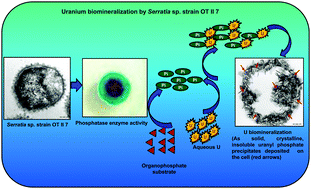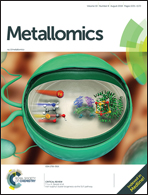Uranium biomineralization induced by a metal tolerant Serratia strain under acid, alkaline and irradiated conditions†
Abstract
It has become increasingly apparent that the environmental microorganisms residing in uranium (U) enriched sites offer the possibility of understanding the biological mechanisms catalyzing the processes important for uranium bioremediation. Here, we present the results of uranium biomineralization over a wide pH range by a metal tolerant Serratia sp. strain OT II 7 isolated from the subsurface soil of a U ore deposit at Domiasiat in India. The Serratia cells actively expressed acid and alkaline phosphatase enzymes which hydrolyzed differential amounts of phosphate from an organophosphate substrate in the presence of uranium between pH 5 to 9. These cells precipitated ∼91% uranium from aqueous solutions supplemented with 1 mM uranyl nitrate at pH 5 within 120 h. More rapid precipitation was observed at pH 7 and 9 wherein the cells removed ∼93–94% of uranium from solutions containing 1 mM uranyl carbonate within 24 h. The aqueous uranyl speciation prevalent under the studied pH conditions influenced the localization of crystalline uranyl phosphate precipitates, which in turn, impacted the cell viability to a great extent. Furthermore, the cells tolerated up to ∼1.6 kGy 60Co gamma radiation and their uranium precipitation abilities at pH 5, 7 and 9 were uncompromised even after exposure to a high dose of ionizing radiation. Overall, this study establishes the ecological adaptation of a natural strain like Serratia in a uranium enriched environment and corroborates its contribution towards uranium immobilization in contaminated subsurfaces through the formation of stable uranyl phosphate minerals over a wide pH range.



 Please wait while we load your content...
Please wait while we load your content...